ANCHOR-Grid: Authenticating Smart Grid Digital Twins Using Real-World Anchors
Abstract
1. Introduction
- Expansion of Environmental Fingerprinting into Virtual Worlds. Pioneering application in the Metaverse, our work extends the concept of environmental fingerprinting beyond physical and network security to virtual DT environments, an unexplored area.
- Protection of Critical Infrastructure. Contributing to smart grid security by proposing a novel authentication mechanism that bridges the physical and virtual worlds and addresses a critical gap in existing security measures against Deepfake attacks in critical infrastructure systems.
- Real-World Validation via Smart Grid Case Study. We validated the proposed ANCHOR-Grid in a virtual IoSGT environment, demonstrating its ability to distinguish authentic DTs from Deepfakes using ENF signatures and its practicality and scalability for smart grid security.
2. Background and Related Works
2.1. Data Security in the Metaverse
2.2. ENF Signals as an Environmental Fingerprint
2.3. Digital Twins in Smart Grids
3. ANCHOR-Grid: Rationale and Design
3.1. Architecture Overview
- Location 1 is an industrial environment with various facilities connected to the power grid (black solid lines). The data network links each facility to the cloud, allowing data aggregation, including ENF readings from this location. The ENF data are a unique identifier consistent in all locations connected to the same power grid, making it a reliable feature to detect data manipulations.
- Location 2 represents a residential area, including homes and electric vehicle charging stations. The ENF signature captured here provides a unique, location-specific electrical frequency profile that can be cross-referenced with data from other locations for consistency. The ENF signal helps verify the authenticity of the data and prevent malicious Deepfake attacks.
- Location 3 shows a specialized industrial and research facility. This location integrates advanced facilities highly dependent on smart grid technologies, and ENF anchors can help ensure that data from this sensitive location are secure. Any inconsistencies in the ENF signal can indicate potential Deepfake attempts or tampering.
3.2. Rationale of ANCHOR-Grid
3.3. ENF-Based Authentication Module
4. Security Monitoring for Smart Grid
4.1. Attack Scenarios
4.1.1. Scenario 1: Injecting a Fake DT of a Power Substation
- Real-Time ENF Verification: The fake DT lacks real-time ENF signals because the attacker cannot generate valid frequency variations that align with the actual fluctuations of the grid. ANCHOR-Grid’s ENF verification module detects anomalies in the DT’s reported frequency signature, immediately flagging it as a non-authentic entity.
- Blockchain-Based Cross-Validation: The blockchain-based authentication layer further ensures that every DT’s ENF signature is validated across multiple nodes, making it impossible for a fake DT to pass authentication. Since the attacker cannot match the expected ENF sequence from the legitimate power substation, the fraudulent DT is automatically rejected.
4.1.2. Scenario 2: Replay Attack Using Historical ENF Data
- Time-Sensitive ENF Authentication: ENF signals are highly time-sensitive; each time-stamped signal correlates to a specific moment in real-world grid conditions. If an attacker replays an ENF signature from an earlier time, it will not match the real-time fluctuations occurring in the grid, leading to immediate detection.
- Blockchain-Recorded ENF Trend Comparison: ANCHOR-Grid compares the incoming ENF data with the trend recorded on the blockchain for ENF. Since historical ENF data do not align with real-time variations, the system automatically detects the mismatch and rejects the replayed DT.
- Timestamp-to-ENF Correlation Analysis: If the timestamp of the replayed attack data does not align with the expected ENF signature, the system flags the DT as inauthentic and denies access.
4.1.3. Scenario 3: Deepfake DTs Generating Synthetic Data
- Inability to Replicate Real-Time ENF Fluctuations: While AI-generated Deepfake DTs can simulate sensor outputs and operational patterns, they cannot replicate real-time ENF fluctuations, which are intrinsically tied to the physical grid. Any DT lacking a real-time ENF correlation is automatically flagged as suspicious.
- Correlation Threshold-Based Authentication: ANCHOR-Grid sets a strict ENF correlation threshold (0.8), ensuring that only genuine ENF data extracted in real-time passes authentication. If a Deepfake DT fails to align with actual grid conditions, it is immediately rejected from the system.
- Cross-Validation with Physical Grid Data: The system cross-checks the DT’s reported ENF signature against real-world smart grid fluctuations. Since Deepfake DTs cannot interact with physical power systems, they lack the correct ENF fingerprint and fail authentication.
4.2. ANCHOR-Grid Microverse
4.3. Micorgrid Monitoring in the Microverse
4.3.1. Digital Twin Integration and Real-Time Data Acquisition
4.3.2. Operational Analysis and Real-Time Monitoring
4.3.3. Security Monitoring and Attack Detection
5. Experimental Study
5.1. Experimental Setup
5.1.1. Physical Testbed
5.1.2. ENF-Based Signature
- Extracting ENF Data Window: A window of ENF data is extracted from the power grid. The specific security requirements determine the length of the window—typically, a 10-s window is used, during which the ENF value is sampled every second. This yields a sequence of ENF values, e.g., [60.01, 59.98, 60.02, 59.99, 59.97, …].
- Normalization of the ENF Data: To prepare the data for signature generation, min-max normalization is applied to scale the ENF values between 0 and 1. This helps in maintaining consistency across different environments. For instance, if is 59.96 and is 60.03, each value in the sequence is normalized as:
- Smoothing the ENF Data: Given that ENF data can be noisy, a moving average technique is used to smooth the sequence. This removes minor fluctuations, making the resulting signature more robust. Using a 3-point moving average, the smoothed sequence might look like [0.428, 0.619, 0.524, …].
- Hashing to Generate a Fixed-Length Signature: The smoothed ENF sequence is concatenated into a single string and then hashed using a cryptographic hash function, such as SHA-384, to generate a fixed-length ENF signature. This signature acts as a watermark that ties the data to real-world conditions in the grid. For instance, the hash output might look like:
- Generating data packet structure with JSON format typically includes metadata such as packet ID, device ID, timestamp, and the data payload (e.g., sensor readings). The structure of the data packet is as follows:
- -
- Packet ID: A unique identifier, e.g., “P164205785600”.
- -
- Device ID: The identifier for the originating device, e.g., “Device01”.
- -
- Timestamp: When the packet was generated, e.g., “2024-11-11T12:30:45Z”.
- -
- Data Payload: Sensor readings or measurements, e.g., {“temperature”: 25.4, “power_usage”: 12.5}.
Once the data packet is generated, it is serialized to a JSON string and hashed using a cryptographic hash function, such as SHA-384, to produce a fixed-length message. Afterward, the ENF signature is combined with the hashed packet to form the final message. For the combination process, three approaches were followed:- -
- Concatenation: Concatenate the two hashed values, deciding the order based on the timestamp. For example, if the timestamp is even, ; otherwise, .
- -
- Interleaving: Use an empty list to store the combined result. Generate the message by iterating through each bit or byte of Hash1 and Hash2, appending them according to the interleaving rule determined by the timestamp. For example, if the timestamp is even, start by appending a byte from Hash1, followed by a byte from Hash2, and repeat.
- -
- Pseudorandom Number Generator (PRNG): SHA-384 produces a hash of 48 bytes (or 96 hexadecimal characters). First, we generate a seed number based on the milliseconds of time we used in the packet to create 48 fixed random numbers within the range [0, 95]. These numbers are then used to place and in a 96-byte vector, which is subsequently sent to the server as a message.
At first, we applied each approach independently. Then, to improve the randomness of , we employed a sequence of random combinations, utilizing different methods to create the message. This combination is derived from five approaches: two strategies for concatenation, two for interleaving, and one using the PRNG. One of these approaches is randomly selected (based on the seed number used in the PRNG) to generate the final message. Then, the final message is hashed and encapsulated in a JSON packet for transmission to the server.
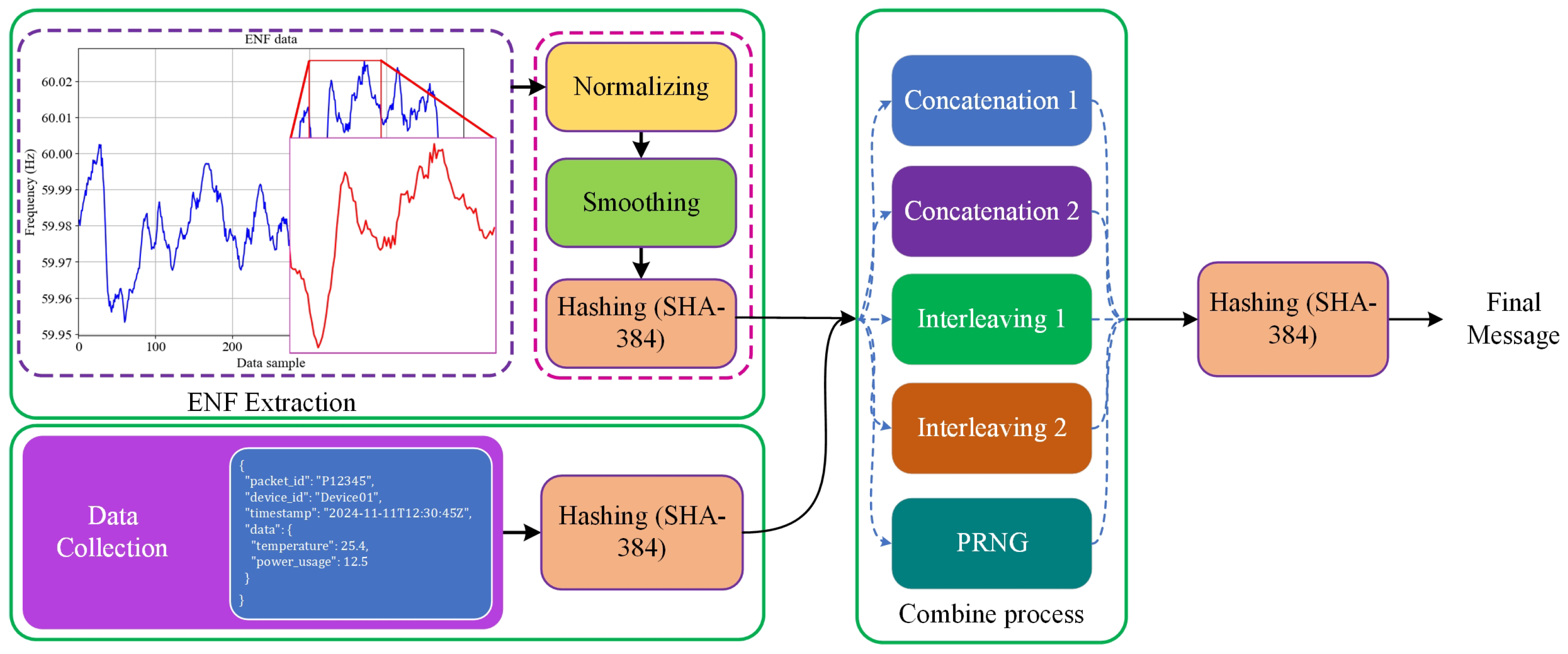
5.1.3. Evaluation Model
5.1.4. Methodology
- Resilience to Replay Attacks: Replay attacks involve capturing previously valid authentication data and reusing it to gain unauthorized access. Many cryptographic methods (e.g., hash-based authentication) mitigate replay attacks using timestamps and challenge-response mechanisms, but they can still be vulnerable to timestamp manipulation or clock synchronization issues. Physical layer authentication techniques (e.g., RF fingerprinting) generally resist replay attacks but require environmental stability to remain effective. ANCHOR-Grid, however, ensures replay resistance by leveraging real-time ENF fluctuations, which cannot be accurately predicted or replicated outside the physical grid environment.
- Real-Time Performance and Scalability: Authentication mechanisms should operate with minimal latency, especially in real-time systems like smart grids. Cryptographic authentication methods require computational resources for encryption/decryption, which can introduce delays, particularly in resource-constrained IoT devices. Physical layer authentication (e.g., RF fingerprinting) can provide real-time responses but requires specialized signal processing hardware. Sensor-based authentication may involve data aggregation from multiple sources, leading to higher latency. In contrast, ANCHOR-Grid is designed for lightweight, real-time authentication, as ENF extraction and correlation require minimal processing power, enabling instantaneous authentication in distributed environments.
- Adaptability to Dynamic Grid Environments: The smart grid infrastructure is highly dynamic, and the components continuously join and leave the network. Authentication mechanisms must be adaptive to changes in network topology and variable environmental conditions. Cryptographic approaches often require centralized key distribution, making them less flexible in large-scale, decentralized networks. Physical layer authentication methods can be susceptible to environmental variations, requiring frequent recalibration. Sensor-based methods rely on stable environmental conditions, limiting their adaptability. However, ANCHOR-Grid naturally adapts to dynamic environments, since ENF signals are inherently synchronized throughout the power grid, eliminating the need for manual adjustments.
- Step 1: Defining Clear Metrics and Objectives
- Step 2: Establishing a Baseline
- Step 3: Creating a Diverse Test Dataset
- Step 4: Performing Controlled Experiments
5.1.5. Evaluation
5.2. Experimental Results
5.2.1. Detection Rates and False Positives
5.2.2. Robustness Under Network Conditions
5.2.3. Comparison Between ANCHOR-Grid and Existing Security Mechanisms
5.2.4. Comparison Between ANCHOR-Grid and Other Authentication-Related Approaches
- Cryptographic-Based Authentication (e.g., Elliptic Curve Cryptography, Hash-Based Authentication): Cryptographic-based authentication methods, such as Elliptic Curve Cryptography (ECC) and Hash-Based Authentication, rely on digital signatures, cryptographic hashes, and asymmetric encryption to verify identities. These methods provide strong authentication against unauthorized access and manipulation. However, they depend on pre-shared keys or certificates, introducing vulnerabilities like key compromise, certificate spoofing, and replay attacks. ANCHOR-Grid, in contrast, eliminates reliance on static cryptographic keys by using real-time ENF signals as a dynamic, naturally occurring authentication factor, making it more resilient to key-based attacks.
- Physical Layer Authentication (e.g., RF Fingerprinting, Power Side-Channel Authentication): Physical layer authentication techniques use hardware-specific characteristics such as RF signal variations, device-specific power-consumption patterns, or side-channel emissions to verify the device’s authenticity. RF fingerprinting uniquely identifies a device based on its wireless transmission characteristics, while power-side channel-authentication analyzes energy-consumption patterns. These methods offer strong resistance to software-based cloning and impersonation attacks. However, their effectiveness depends on specialized hardware requirements and environmental stability (e.g., RF signals can fluctuate due to interference). ANCHOR-Grid provides a more scalable and grid-wide authentication approach, leveraging the inherent ENF signal consistency across interconnected power systems rather than requiring individual device calibration.
- Sensor-Based Authentication (e.g., Multi-Sensor Fusion, Biometric-Inspired Approaches): Sensor-based authentication methods use multimodal sensor inputs to create unique, location-dependent authentication factors. These approaches have been explored in biometric authentication, industrial IoT security, and environmental monitoring. Although effective in certain applications, they often require continuous sensor calibration, suffer from drift over time, and may be vulnerable to sensor spoofing. ANCHOR-Grid leverages the intrinsic, non-replicable nature of real-time ENF variations, making it more resistant to sensor-based spoofing while requiring no additional hardware beyond grid-connected measurement devices.
| Feature | ANCHOR-Grid (ENF-Based) | Cryptographic Authentication (ECC, Hash-Based) [63] | Physical Layer Authentication (RF Fingerprinting, Power Side-Channel) [64] | Sensor-Based Authentication (Multi-Sensor Fusion, Biometric-Inspired) [65] |
|---|---|---|---|---|
| Core Authentication Method | Uses real-time ENF signals as environmental fingerprints to authenticate grid components. | Uses cryptographic keys and digital signatures for verification. | Utilizes hardware-specific properties like RF emissions or power usage. | It relies on sensor data to create authentication patterns. |
| Replay Attack Resilience | High—ENF signals are time-variant and cannot be replayed. | Moderate—Timestamp-based protection, but vulnerable to clock manipulation. | High—Unique physical properties are difficult to replicate. | Low—Sensor data can be captured and replayed. |
| Real-Time Performance | High—ENF extraction and correlation require minimal processing power. | Moderate—Encryption/decryption can introduce computational delays. | High—RF and power-based authentication occur in real-time. | Low—Requires data aggregation and processing from multiple sensors. |
| Scalability | High—No pre-shared keys; applies naturally to grid-wide systems. | Low—Key distribution and management challenges in large networks. | Low—Requires specialized hardware and calibration per device. | Moderate—Scales with sensor networks but increases computational cost. |
| Adaptability to Dynamic Environments | High—ENF signals are naturally synchronized across the power grid. | Low—Requires centralized key management and updates. | Moderate—Environmental factors may impact reliability. | Low—Sensor drift and environmental changes affect accuracy. |
| Hardware Dependency | Low—Uses existing power grid infrastructure; no additional hardware required. | High—Requires cryptographic modules and key storage. | High—Needs specialized RF or power monitoring hardware. | High—Requires deployment of multiple sensors per authentication node. |
| Resistance to Deepfake Attacks | High—ENF signals cannot be artificially generated or Deepfaked. | Low—Deepfake AI can generate fraudulent cryptographic responses. | High—Device-specific RF/power signatures are hard to fake. | Low—AI can generate synthetic sensor data to mimic real-world readings. |
| Tamper Detection | High—Blockchain-based ENF verification prevents data manipulation. | Moderate—Digital signatures protect against tampering but depend on key security. | High—Physical fingerprinting makes tampering difficult. | Low—Sensor readings can be manipulated without detection. |
| Computational Overhead | Low—ENF extraction and correlation are lightweight. | High—cryptographic operations require computational resources. | Moderate—Requires real-time RF/power signal processing. | High—Multi-sensor fusion demands continuous data processing. |
| Implementation Complexity | Moderate—Requires ENF extraction and blockchain integration. | High—Needs cryptographic key infrastructure and certificate management. | High—Demand specialized hardware for RF/power analysis. | High—Requires extensive sensor deployment and data-fusion mechanisms. |
| Security Against Cloning | High—ENF signatures are unique and cannot be replicated. | Low—Cryptographic keys can be stolen or cloned. | High—Hardware properties are unique to each device. | Low—Sensors can be spoofed or cloned. |
6. Conclusions
Author Contributions
Funding
Institutional Review Board Statement
Informed Consent Statement
Data Availability Statement
Acknowledgments
Conflicts of Interest
Abbreviations
| APIs | Application Programming Interfaces |
| AI | Artificial Intelligence |
| DDDAS | Dynamic Data Driven Application Systems |
| DDoS | Distributed Denial-of-Service |
| DDS | Data-Distribution Service |
| DT | Digital Twin |
| DTs | Digital Twins |
| DoS | Denial-of-Service |
| ECC | Elliptic Curve Cryptography |
| ENF | Electric Network Frequency |
| ESS | Energy Storage Systems |
| FNR | False Negative Rate |
| FPR | False Positive Rate |
| GUI | Graphic User Interface |
| IoSGT | Internet of Smart Grid Things |
| IoT | Internet of Things |
| IDS | Intrusion-Detection System |
| LFC | Load Frequency Control |
| LSTM | Long Short Term Memory |
| MQTT | Message Queuing Telemetry Transport |
| PCB | Printed Circuit Board |
| PMUs | Phasor Measurement Units |
| PRNG | Pseudorandom Number Generator |
| SCADA | Supervisory Control and Data Acquisition |
| TCP | Transmission Control Protocol |
| UE5 | Unreal Engine 5 |
References
- Hatami, M.; Qu, Q.; Chen, Y.; Kholidy, H.; Blasch, E.; Ardiles-Cruz, E. A Survey of the Real-Time Metaverse: Challenges and Opportunities. Future Internet 2024, 16, 379. [Google Scholar] [CrossRef]
- Kusuma, A.T.; Supangkat, S.H. Metaverse fundamental technologies for smart city: A literature review. In Proceedings of the 2022 International Conference on ICT for Smart Society (ICISS), Virtual Conference, 10–11 August 2022; pp. 1–7. [Google Scholar]
- Wang, H.; Ning, H.; Lin, Y.; Wang, W.; Dhelim, S.; Farha, F.; Ding, J.; Daneshmand, M. A survey on the Metaverse: The state-of-the-art, technologies, applications, and challenges. IEEE Internet Things J. 2023, 10, 14671–14688. [Google Scholar] [CrossRef]
- Cheng, R.; Wu, N.; Chen, S.; Han, B. Will Metaverse be nextg internet? vision, hype, and reality. IEEE Netw. 2022, 36, 197–204. [Google Scholar] [CrossRef]
- Li, H.; Weng, Y.; Vittal, V.; Blasch, E. Distribution grid topology and parameter estimation using deep-shallow neural network with physical consistency. IEEE Trans. Smart Grid 2023, 15, 655–666. [Google Scholar] [CrossRef]
- Wang, Y.; Su, Z.; Zhang, N.; Xing, R.; Liu, D.; Luan, T.H.; Shen, X. A survey on Metaverse: Fundamentals, security, and privacy. IEEE Commun. Surv. Tutor. 2022, 25, 319–352. [Google Scholar] [CrossRef]
- Wang, J.; Makowski, S.; Cieślik, A.; Lv, H.; Lv, Z. Fake news in virtual community, virtual society, and Metaverse: A survey. IEEE Trans. Comput. Soc. Syst. 2023, 11, 4828–4842. [Google Scholar] [CrossRef]
- Ruiu, P.; Nitti, M.; Pilloni, V.; Cadoni, M.; Grosso, E.; Fadda, M. Metaverse & Human Digital Twin: Digital Identity, Biometrics, and Privacy in the Future Virtual Worlds. Multimodal Technol. Interact. 2024, 8, 48. [Google Scholar] [CrossRef]
- Thakur, G.; Kumar, P.; Chen, C.M.; Vasilakos, A.V.; Prajapat, S.; Prajapat, S. A robust privacy-preserving ecc-based three-factor authentication scheme for Metaverse environment. Comput. Commun. 2023, 211, 271–285. [Google Scholar] [CrossRef]
- Blasch, E.; Bastian, N.D.; Aved, A.; Ardiles-Cruz, E. Human-machine cooperative AI decision-making with heterogeneous data. In Proceedings of the Signal Processing, Sensor/Information Fusion, and Target Recognition XXXII, SPIE, Orlando, FL, USA, 30 April–5 May 2023; Volume 12547, pp. 162–171. [Google Scholar]
- Gupta, B.B.; Gaurav, A.; Arya, V. Fuzzy logic and biometric-based lightweight cryptographic authentication for Metaverse security. Appl. Soft Comput. 2024, 164, 111973. [Google Scholar] [CrossRef]
- Nagothu, D.; Poredi, N.; Chen, Y. Evolution of Attacks on Intelligent Surveillance Systems and Effective Detection Techniques. In Intelligent Video Surveillance-New Perspectives; IntechOpen: London, UK, 2022. [Google Scholar]
- Abdelkader, S.; Amissah, J.; Kinga, S.; Mugerwa, G.; Emmanuel, E.; Mansour, D.E.A.; Bajaj, M.; Blazek, V.; Prokop, L. Securing modern power systems: Implementing comprehensive strategies to enhance resilience and reliability against cyber-attacks. Results Eng. 2024, 23, 102647. [Google Scholar] [CrossRef]
- Fan, Y.; Zhang, L.; Li, D.; Wang, Z. Progress in self-powered, multi-parameter, micro sensor technologies for power Metaverse and smart grids. Nano Energy 2023, 118, 108959. [Google Scholar] [CrossRef]
- Tatipatri, N.; Arun, S. A Comprehensive Review on Cyber-attacks in Power Systems: Impact Analysis, Detection and Cyber security. IEEE Access 2024, 12, 18147–18167. [Google Scholar] [CrossRef]
- Nagothu, D.; Xu, R.; Chen, Y.; Blasch, E.; Aved, A. Deterring Deepfake attacks with an electrical network frequency fingerprints approach. Future Internet 2022, 14, 125. [Google Scholar] [CrossRef]
- Nagothu, D.; Xu, R.; Chen, Y.; Blasch, E.; Aved, A. Defakepro: Decentralized Deepfake attacks detection using enf authentication. IT Prof. 2022, 24, 46–52. [Google Scholar] [CrossRef]
- Jafari, M.; Kavousi-Fard, A.; Dabbaghjamanesh, M.; Karimi, M. A survey on deep learning role in distribution automation system: A new collaborative Learning-to-Learning (L2L) concept. IEEE Access 2022, 10, 81220–81238. [Google Scholar] [CrossRef]
- Maheshwari, R.U.; Paulchamy, B.; Pandey, B.K.; Pandey, D. Enhancing Sensing and Imaging Capabilities Through Surface Plasmon Resonance for Deepfake Image Detection. Plasmonics 2024, 20, 2945–2964. [Google Scholar] [CrossRef]
- Mirzaee, P.H.; Shojafar, M.; Cruickshank, H.; Tafazolli, R. Smart grid security and privacy: From conventional to machine learning issues (threats and countermeasures). IEEE Access 2022, 10, 52922–52954. [Google Scholar] [CrossRef]
- Dsouza, D.S.; Hajjar, A.E.; Jahankhani, H. Deepfakes in Social Engineering Attacks. In Space Law Principles and Sustainable Measures; Springer: Berlin/Heidelberg, Germany, 2024; pp. 153–183. [Google Scholar]
- Mustak, M.; Salminen, J.; Mäntymäki, M.; Rahman, A.; Dwivedi, Y.K. Deepfakes: Deceptions, mitigations, and opportunities. J. Bus. Res. 2023, 154, 113368. [Google Scholar] [CrossRef]
- Alrawili, R.; AlQahtani, A.A.S.; Khan, M.K. Comprehensive survey: Biometric user authentication application, evaluation, and discussion. Comput. Electr. Eng. 2024, 119, 109485. [Google Scholar] [CrossRef]
- Husnoo, M.A.; Anwar, A.; Hosseinzadeh, N.; Islam, S.N.; Mahmood, A.N.; Doss, R. False data injection threats in active distribution systems: A comprehensive survey. Future Gener. Comput. Syst. 2023, 140, 344–364. [Google Scholar] [CrossRef]
- Nguyen, L.H.; Nguyen, V.L.; Hwang, R.H.; Kuo, J.J.; Chen, Y.W.; Huang, C.C.; Pan, P.I. Towards Secured Smart Grid 2.0: Exploring Security Threats, Protection Models, and Challenges. IEEE Commun. Surv. Tutor. 2024. early access. [Google Scholar] [CrossRef]
- Ngharamike, E.; Ang, L.M.; Seng, K.P.; Wang, M. ENF based digital multimedia forensics: Survey, application, challenges and future work. IEEE Access 2023, 11, 101241–101272. [Google Scholar] [CrossRef]
- Khan, A.A.; Laghari, A.A.; Rashid, M.; Li, H.; Javed, A.R.; Gadekallu, T.R. Artificial intelligence and blockchain technology for secure smart grid and power distribution Automation: A State-of-the-Art Review. Sustain. Energy Technol. Assess. 2023, 57, 103282. [Google Scholar]
- Mihai, S.; Yaqoob, M.; Hung, D.V.; Davis, W.; Towakel, P.; Raza, M.; Karamanoglu, M.; Barn, B.; Shetve, D.; Prasad, R.V.; et al. Digital twins: A survey on enabling technologies, challenges, trends and future prospects. IEEE Commun. Surv. Tutor. 2022, 24, 2255–2291. [Google Scholar] [CrossRef]
- Kumar, D.K.; Reddy, K.K.; Kathrine, G.J.W. Smart Grid Protection with AI and Cryptographic Security. In Proceedings of the 2024 3rd International Conference on Applied Artificial Intelligence and Computing (ICAAIC), Salem, India, 5–7 June 2024; pp. 246–251. [Google Scholar]
- Qu, Q.; Xu, R.; Sun, H.; Chen, Y.; Sarkar, S.; Ray, I. A Digital Healthcare Service Architecture for Seniors Safety Monitoring in Metaverse. In Proceedings of the 2023 IEEE International Conference on Metaverse Computing, Networking and Applications (MetaCom), Kyoto, Japan, 26–28 June 2023; pp. 86–93. [Google Scholar]
- Menezes, C.; França, B.; Lopes, Y. A survey on extended reality, digital twins, and Metaverse applications in power systems. IEEE Internet Things J. 2024, 11, 34953–34977. [Google Scholar] [CrossRef]
- Saxena, A.; Shankar, R.; Kumar, C.; Parida, S. A resilient frequency regulation for enhancing power system security against hybrid cyber-attacks. IEEE Trans. Ind. Appl. 2024, 60, 4583–4597. [Google Scholar] [CrossRef]
- Khan, M.H.D.; Imtiaz, J.; Islam, M.N.U. A blockchain based secure decentralized transaction system for energy trading in microgrids. IEEE Access 2023, 11, 47236–47257. [Google Scholar] [CrossRef]
- Roumeliotis, C.; Dasygenis, M.; Lazaridis, V.; Dossis, M. Blockchain and Digital Twins in Smart Industry 4.0: The Use Case of Supply Chain-A Review of Integration Techniques and Applications. Designs 2024, 8, 105. [Google Scholar] [CrossRef]
- Chapagain, D.; Kshetri, N.; Aryal, B. Deepfake Disasters: A Comprehensive Review of Technology, Ethical Concerns, Countermeasures, and Societal Implications. In Proceedings of the 2024 International Conference on Emerging Trends in Networks and Computer Communications (ETNCC), Windhoek, Namibia, 23–25 July 2024; pp. 1–9. [Google Scholar]
- Jithish, J.; Alangot, B.; Mahalingam, N.; Yeo, K.S. Distributed anomaly detection in smart grids: A federated learning-based approach. IEEE Access 2023, 11, 7157–7179. [Google Scholar] [CrossRef]
- Yang, K.; Zhang, Z.; Youliang, T.; Ma, J. A secure authentication framework to guarantee the traceability of avatars in Metaverse. IEEE Trans. Inf. Forensics Secur. 2023, 18, 3817–3832. [Google Scholar] [CrossRef]
- Alimi, O.A.; Ouahada, K.; Abu-Mahfouz, A.M. A review of machine learning approaches to power system security and stability. IEEE Access 2020, 8, 113512–113531. [Google Scholar] [CrossRef]
- Awadallah, A.; Eledlebi, K.; Zemerly, J.; Puthal, D.; Damiani, E.; Taha, K.; Kim, T.Y.; Yoo, P.D.; Choo, K.K.R.; Yim, M.S.; et al. Artificial intelligence-based cybersecurity for the Metaverse: Research challenges and opportunities. IEEE Commun. Surv. Tutor. 2024, 27, 1008–1052. [Google Scholar] [CrossRef]
- Elgarhy, I.; Badr, M.M.; Mahmoud, M.; Nabil, M.; Alsabaan, M.; Ibrahem, M.I. Securing smart grid false data detectors against white-box evasion attacks without sacrificing accuracy. IEEE Internet Things J. 2024, 11, 33873–33889. [Google Scholar] [CrossRef]
- Liu, Y.; You, S.; Yao, W.; Cui, Y.; Wu, L.; Zhou, D.; Zhao, J.; Liu, H.; Liu, Y. A Distribution Level Wide Area Monitoring System for the Electric Power Grid–FNET/GridEye. IEEE Access 2017, 5, 2329–2338. [Google Scholar] [CrossRef]
- Hua, G.; Liao, H.; Wang, Q.; Zhang, H.; Ye, D. Detection of electric network frequency in audio recordings–from theory to practical detectors. IEEE Trans. Inf. Forensics Secur. 2020, 16, 236–248. [Google Scholar] [CrossRef]
- Nagothu, D.; Xu, R.; Chen, Y.; Blasch, E.; Ardiles-Cruz, E. Application of Electrical Network Frequency as an Entropy Generator in Distributed Systems. In Proceedings of the NAECON 2023-IEEE National Aerospace and Electronics Conference, Fairborn, OH, USA, 28–31 August 2023; pp. 233–238. [Google Scholar]
- Nagothu, D.; Chen, Y.; Blasch, E.; Aved, A.; Zhu, S. Detecting malicious false frame injection attacks on surveillance systems at the edge using electrical network frequency signals. Sensors 2019, 19, 2424. [Google Scholar] [CrossRef]
- Darema, F.; Blasch, E.; Ravela, S.; Aved, A.J. Handbook of Dynamic Data Driven Applications Systems; Springer: Berlin/Heidelberg, Germany, 2023; Volume 2. [Google Scholar]
- Hatami, M.; Nasab, M.A.; Chen, Y.; Mohammadi, J.; Cruz, E.A.; Blasch, E. Optimizing Energy Storage Systems Deployment in Smart Grids. In Proceedings of the 2024 IEEE ANDESCON, Cusco, Peru, 11–14 September 2024; pp. 1–6. [Google Scholar]
- Kumari, N.; Sharma, A.; Tran, B.; Chilamkurti, N.; Alahakoon, D. A comprehensive review of digital twin technology for grid-connected microgrid systems: State of the art, potential and challenges faced. Energies 2023, 16, 5525. [Google Scholar] [CrossRef]
- Blasch, E. Digital Twins for Cognitive Situation Awareness. In Proceedings of the 2024 IEEE Conference on Cognitive and Computational Aspects of Situation Management (CogSIMA), Montreal, QC, Canada, 7–10 May 2024; pp. 63–70. [Google Scholar]
- Mchirgui, N.; Quadar, N.; Kraiem, H.; Lakhssassi, A. The Applications and Challenges of Digital Twin Technology in Smart Grids: A Comprehensive Review. Appl. Sci. 2024, 14, 10933. [Google Scholar] [CrossRef]
- Hatami, M.; Nasab, M.A.; Chen, Y.; Mohammadi, J.; Ardiles-Cruz, E.; Blasch, E. ELOCESS: An ESS Management Framework for Improved Smart Grid Stability and Flexibility. IEEE Trans. Consum. Electron. 2024. [Google Scholar] [CrossRef]
- Djebali, S.; Guerard, G.; Taleb, I. Survey and insights on digital twins design and smart grid’s applications. Future Gener. Comput. Syst. 2023, 153, 234–248. [Google Scholar] [CrossRef]
- Nasab, M.A.; Hatami, M.; Zand, M.; Nasab, M.A.; Padmanaban, S. Demand side management programs in smart grid through cloud computing. Renew. Energy Focus 2024, 51, 100639. [Google Scholar] [CrossRef]
- Jafari, M.; Kavousi-Fard, A.; Chen, T.; Karimi, M. A review on digital twin technology in smart grid, transportation system and smart city: Challenges and future. IEEE Access 2023, 11, 17471–17484. [Google Scholar] [CrossRef]
- Padmanaban, S.; Nasab, M.A.; Milani, O.H.; Zand, M.; Hatami, M.; Nasab, M.A.; Khalili, M. Robust Rearrangement of Interconnected Microgrids to Reduce the Effects of Physical Cyberattacks on Intelligent Distribution Networks. In Biomass and Solar-Powered Sustainable Digital Cities; Scrivener Publishing LLC: Austin, TX, USA, 2024; pp. 339–362. [Google Scholar]
- Padmanaban, S.; Nasab, M.A.; Hatami, M.; Milani, O.H.; Dashtaki, M.A.; Nasab, M.A.; Zand, M. The Impact of the Internet of Things in the Smart City from the Point of View of Energy Consumption Optimization. In Biomass and Solar-Powered Sustainable Digital Cities; Scrivener Publishing LLC: Beverly, MA, USA, 2024; pp. 81–122. [Google Scholar]
- Kabir, M.R.; Halder, D.; Ray, S. Digital Twins for IoT-driven Energy Systems: A Survey. IEEE Access 2024, 12, 177123–177143. [Google Scholar] [CrossRef]
- Blasch, E.; Sabatini, R.; Roy, A.; Kramer, K.A.; Andrew, G.; Schmidt, G.T.; Insaurralde, C.C.; Fasano, G. Cyber awareness trends in avionics. In Proceedings of the 2019 IEEE/AIAA 38th Digital Avionics Systems Conference (DASC), San Diego, CA, USA, 8–12 September 2019; pp. 1–8. [Google Scholar]
- Zhang, M.; Sonnadara, C.; Shah, S.; Wu, M. Feasibility Study of Location Authentication for IoT Data Using Power Grid Signatures. IEEE Open J. Signal Process. 2025, 6, 405–416. [Google Scholar] [CrossRef]
- Qu, Q.; Hatami, M.; Xu, R.; Nagothu, D.; Chen, Y.; Li, X.; Blasch, E.; Ardiles-Cruz, E.; Chen, G. The Microverse: A Task-Oriented Edge-Scale Metaverse. Future Internet 2024, 16, 60. [Google Scholar] [CrossRef]
- Owusu, E.; Rahouti, M.; Jagatheesaperumal, S.K.; Xiong, K.; Xin, Y.; Lu, L.; Hsu, D.F. Online Network DoS/DDoS Detection: Sampling, Change Point Detection, and Machine Learning Methods. IEEE Commun. Surv. Tutor. 2024. [Google Scholar] [CrossRef]
- Horak, T.; Strelec, P.; Huraj, L.; Tanuska, P.; Vaclavova, A.; Kebisek, M. The vulnerability of the production line using industrial IoT systems under ddos attack. Electronics 2021, 10, 381. [Google Scholar] [CrossRef]
- Ren, M.; Fu, X.; Pace, P.; Aloi, G.; Fortino, G. Collaborative data acquisition for UAV-aided IoT based on time-balancing scheduling. IEEE Internet Things J. 2023, 11, 13660–13676. [Google Scholar] [CrossRef]
- Lahraoui, Y.; Lazaar, S.; Amal, Y.; Nitaj, A. Securing Data Exchange with Elliptic Curve Cryptography: A Novel Hash-Based Method for Message Mapping and Integrity Assurance. Cryptography 2024, 8, 23. [Google Scholar] [CrossRef]
- Zhou, Q.; He, Y.; Yang, K.; Chi, T. Physical-layer identification of wireless IoT nodes through PUF-controlled transmitter spectral regrowth. IEEE Trans. Microw. Theory Tech. 2023, 72, 1045–1055. [Google Scholar] [CrossRef]
- Shuwandy, M.L.; Jouda, A.; Ahmed, M.; Salih, M.M.; Al-qaysi, Z.; Alamoodi, A.; Garfan, S.; Albahri, O.; Zaidan, B.; Albahri, A. Sensor-based authentication in smartphone: A systematic review. J. Eng. Res. 2024, in press. [CrossRef]
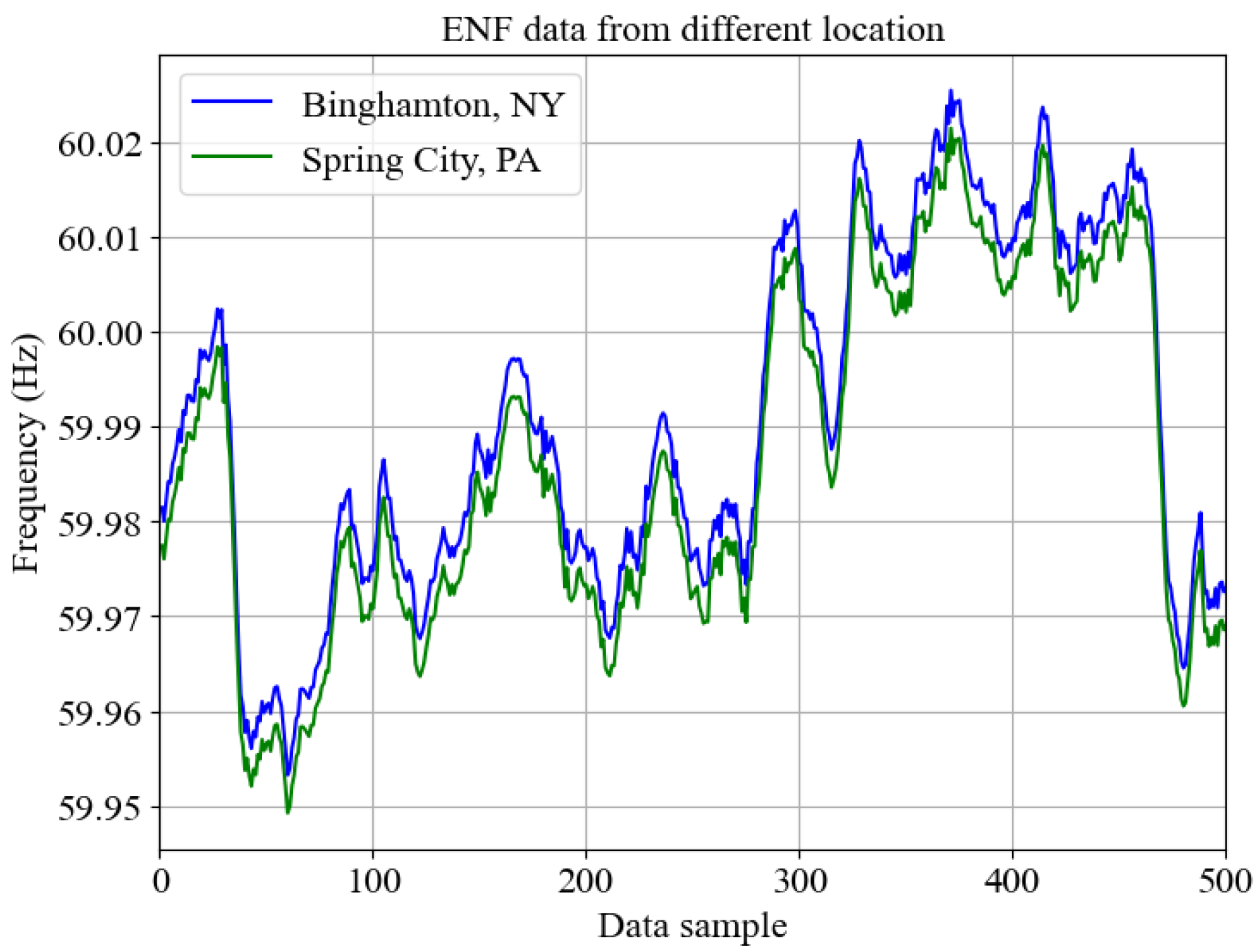
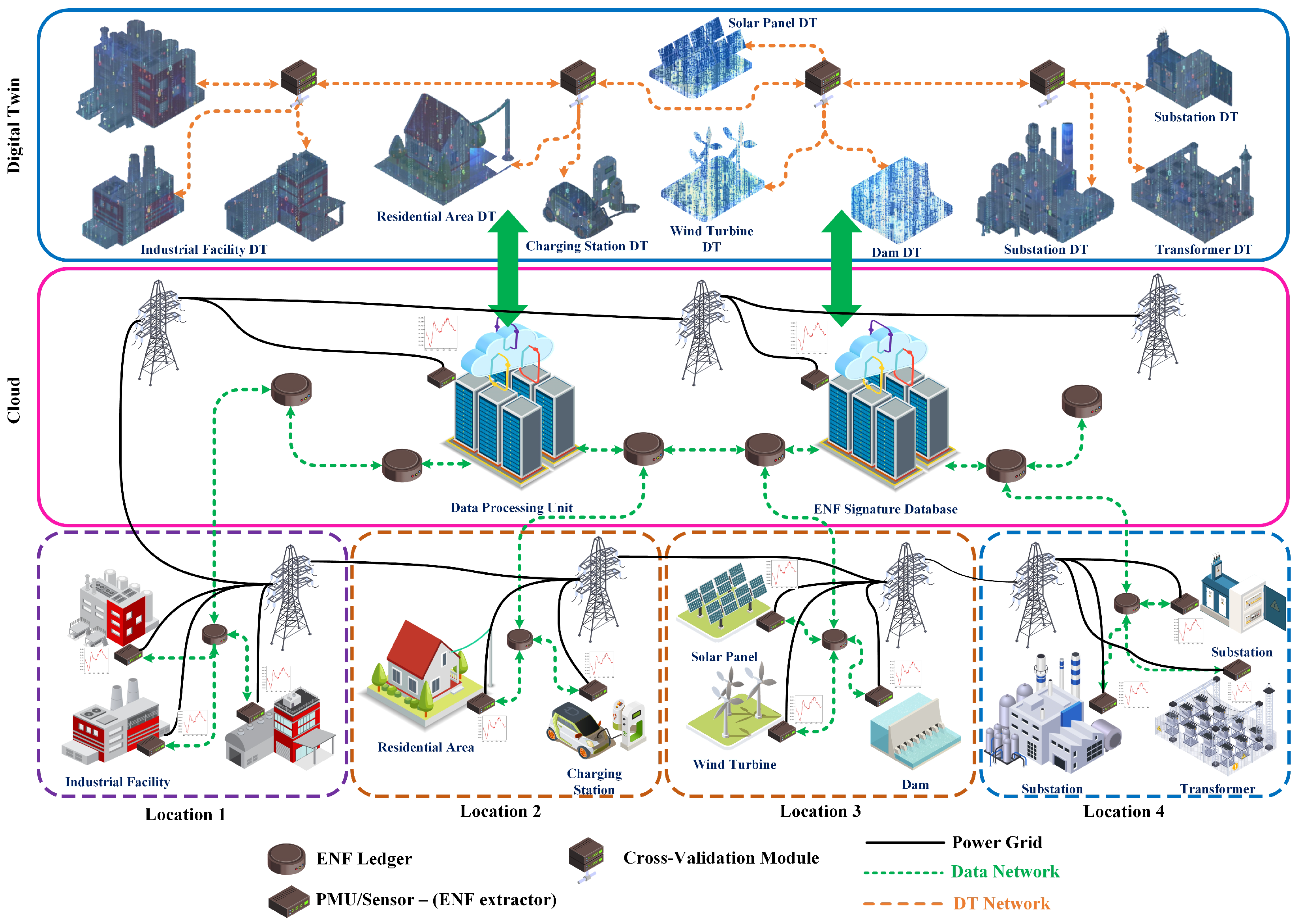
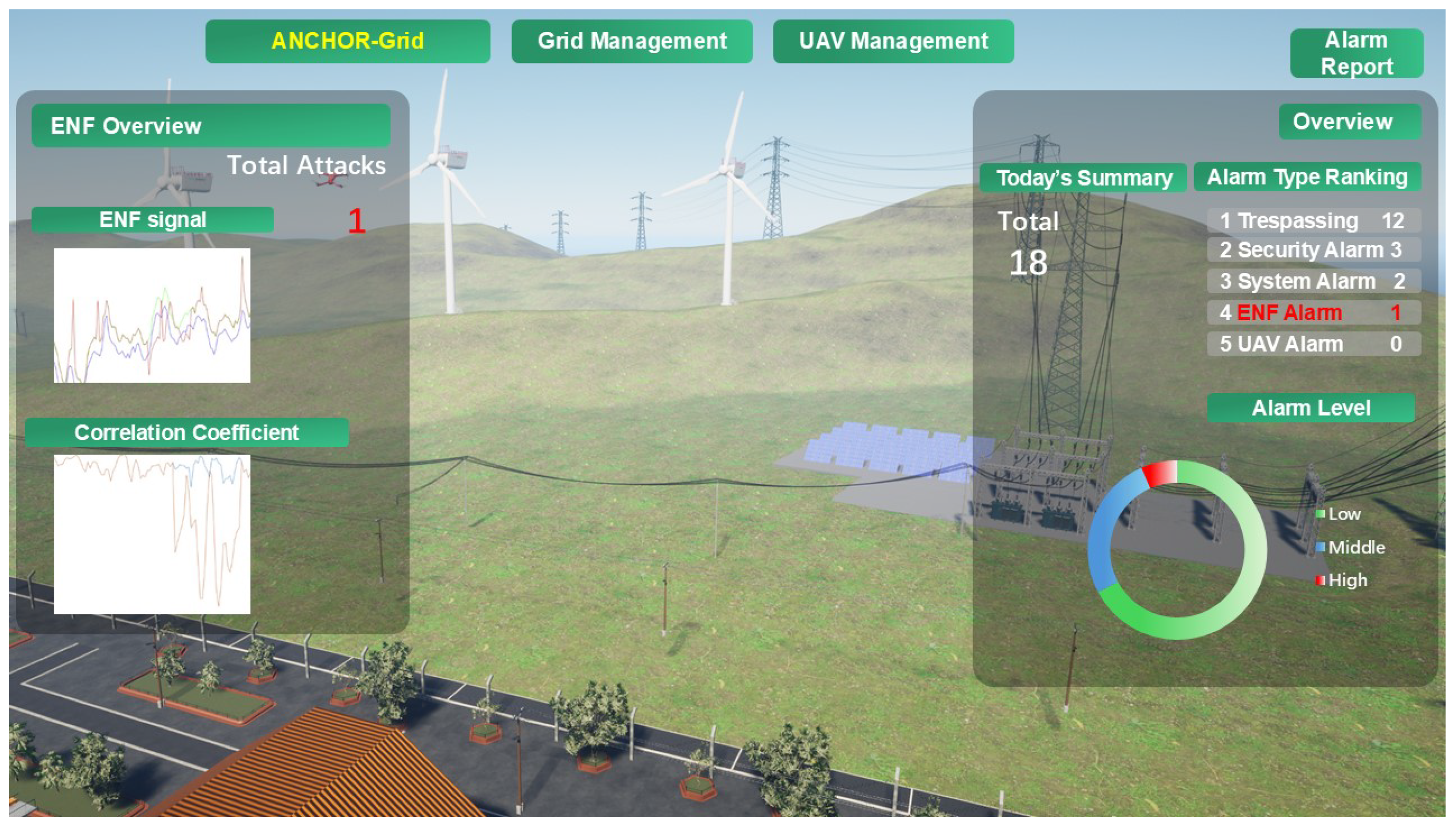
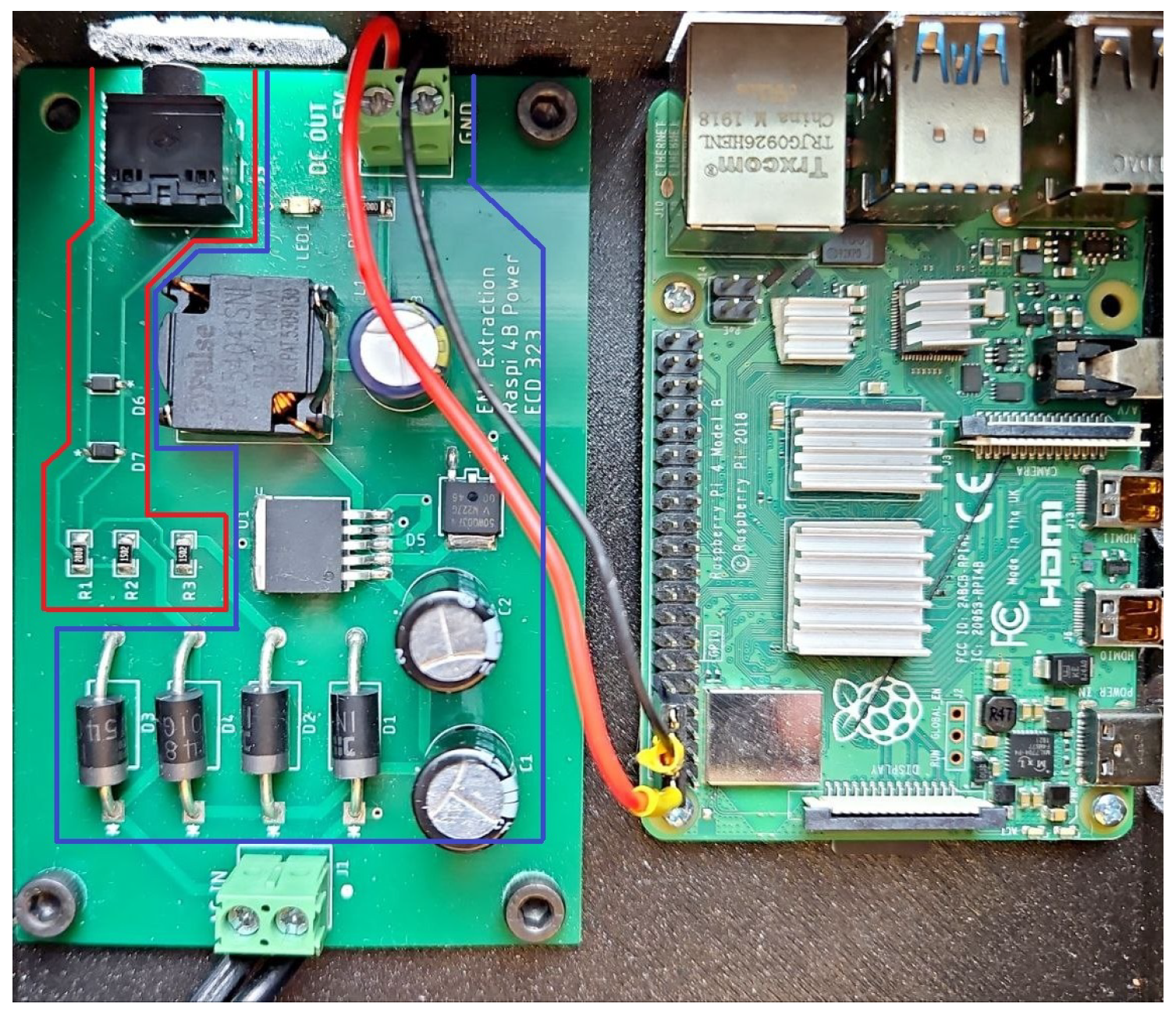
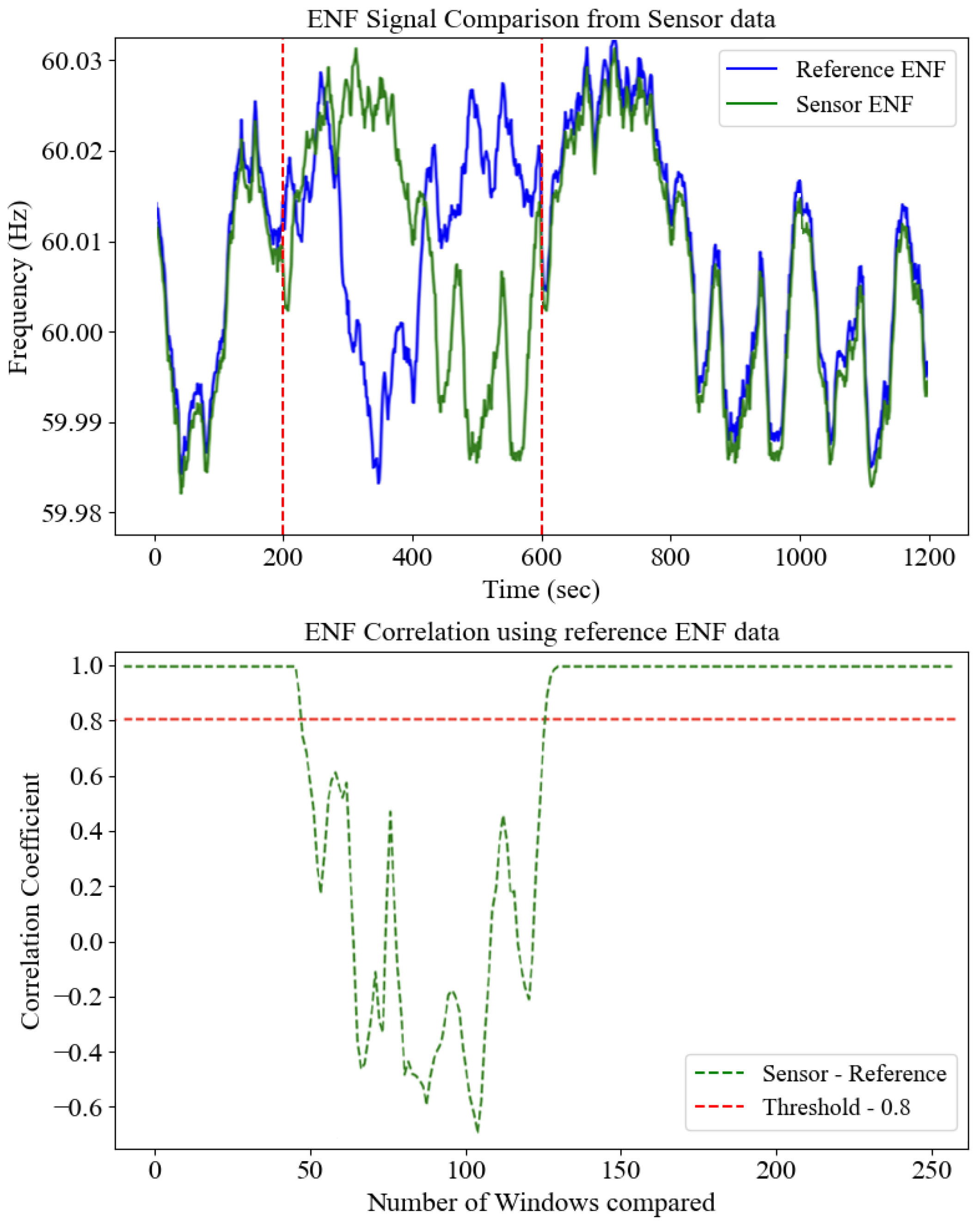
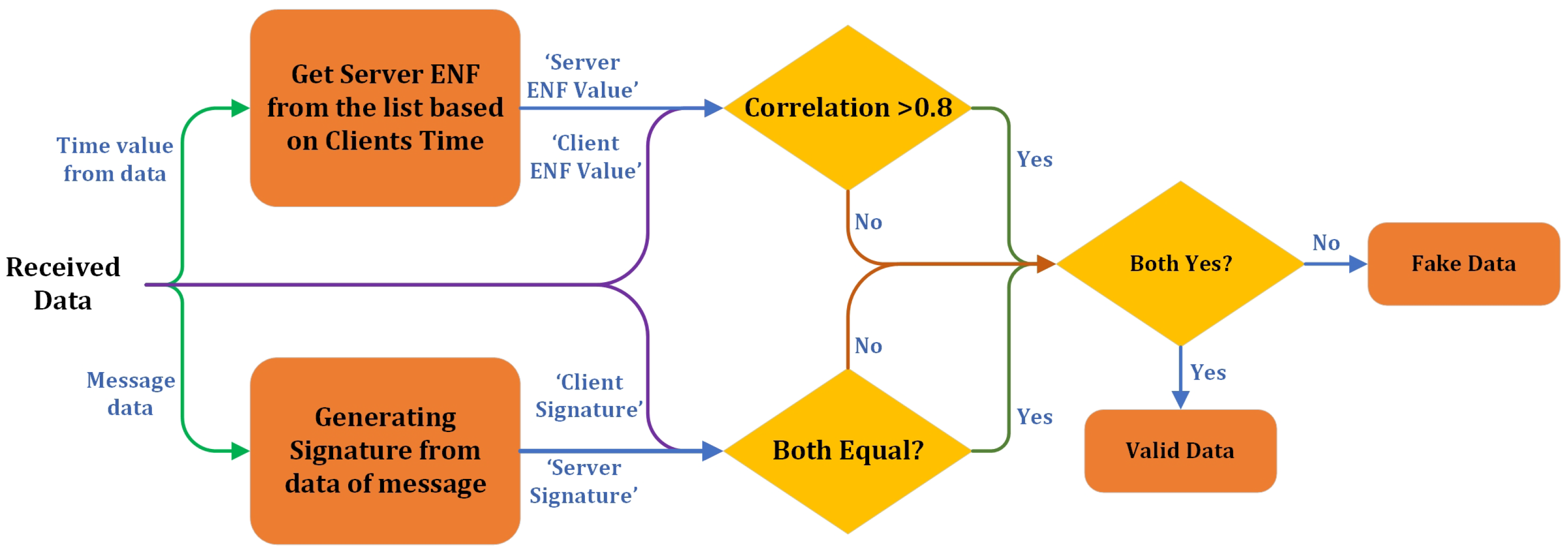
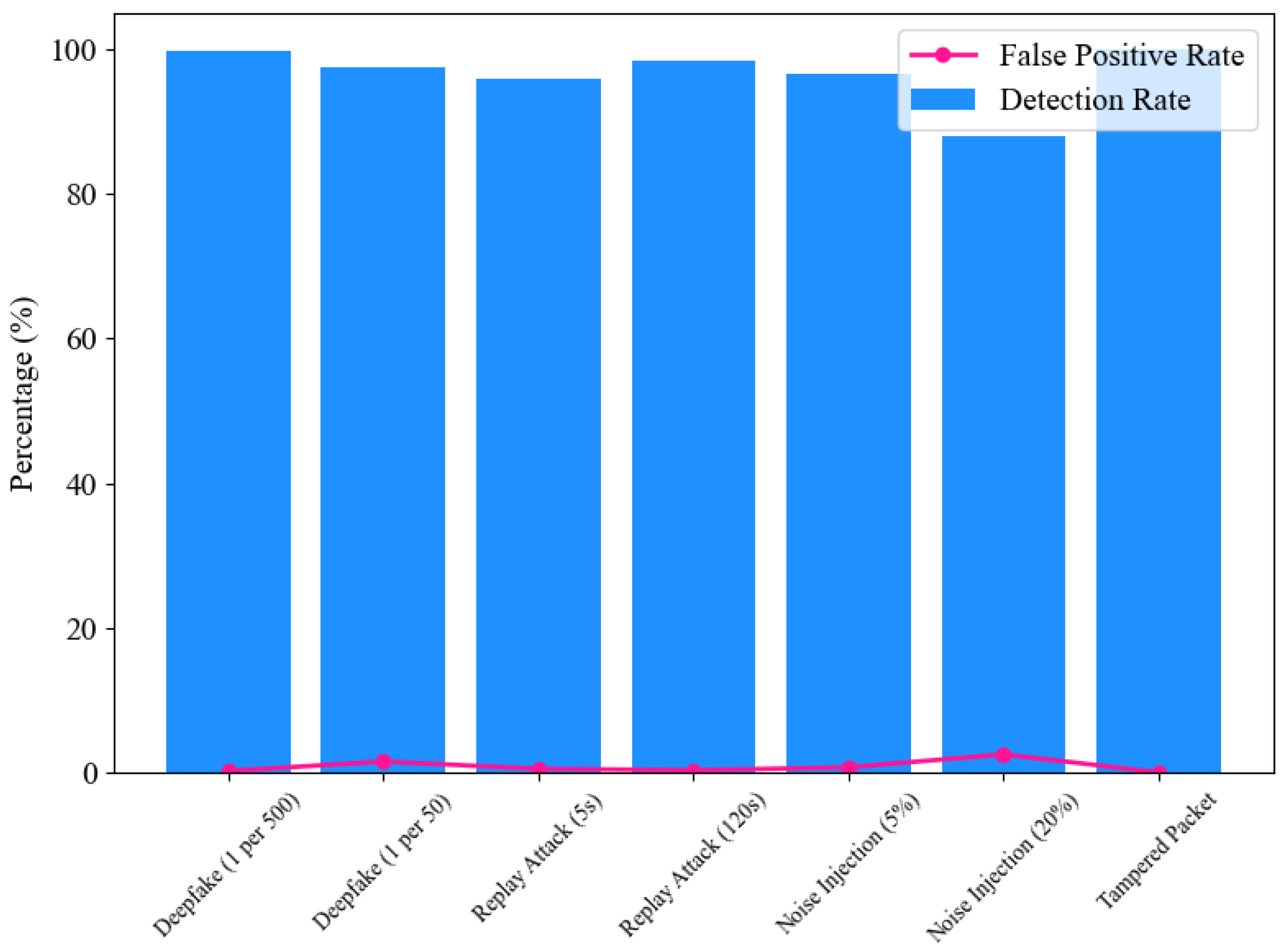
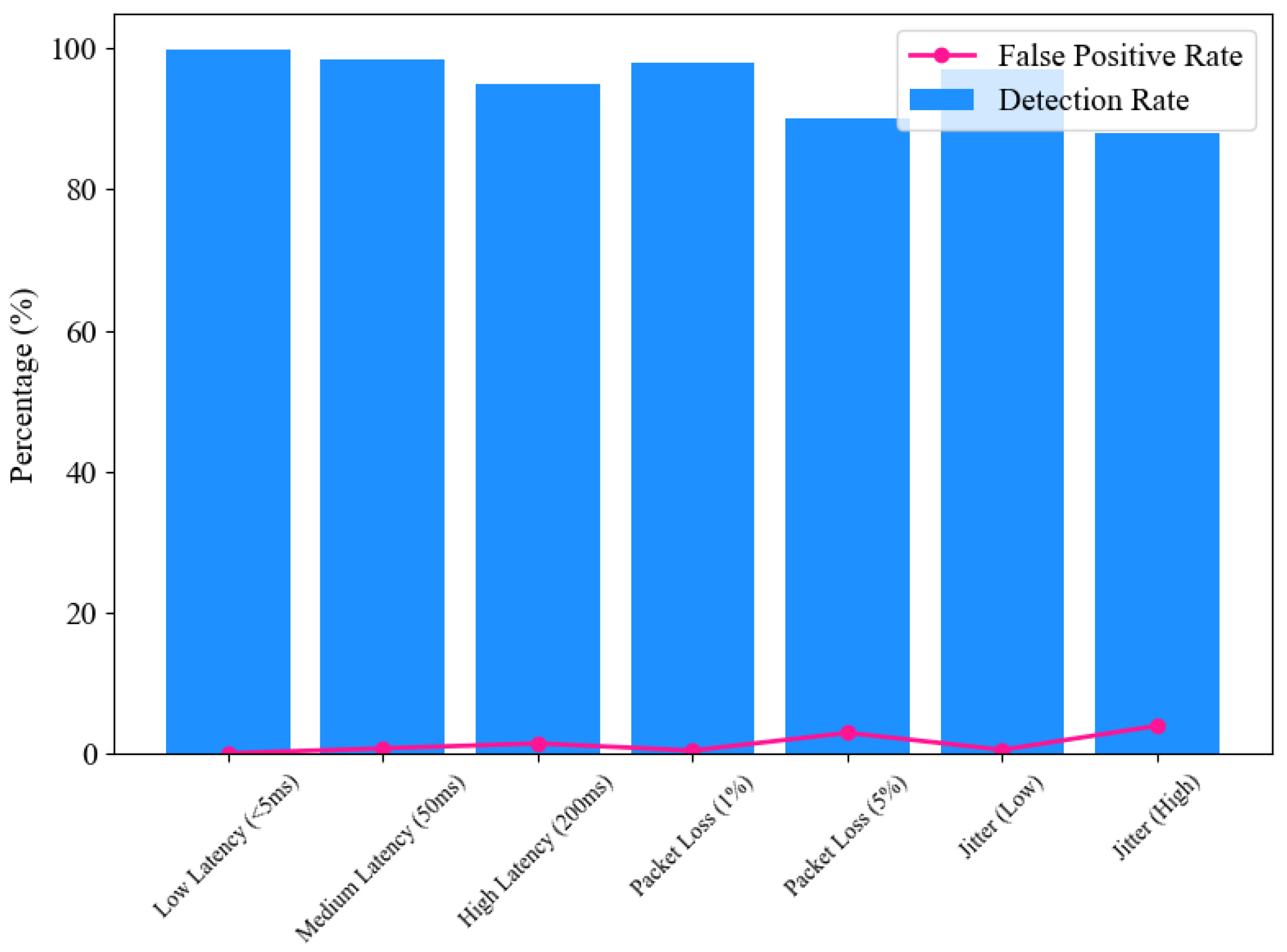
| Attack Type | Precision (%) | Recall (%) | ||
|---|---|---|---|---|
| Baseline | ANCHOR-Grid | Baseline | ANCHOR-Grid | |
| Deepfake (1 per 500) | 91 | 99.8 | 85 | 99.8 |
| Deepfake (1 per 50) | 88 | 98.4 | 80 | 97.5 |
| Replay Attack (5 s old) | 75 | 99.5 | 70 | 94 |
| Replay Attack (120 s old) | 85 | 99.7 | 80 | 98.5 |
| Noise Injection (5% Noise) | 78 | 99.2 | 70 | 96 |
| Noise Injection (20% Noise) | 65 | 97.1 | 60 | 85 |
| Tampered Packet | 90 | 100 | 85 | 100 |
| Network Condition | Precision (%) | Recall (%) |
|---|---|---|
| Low Latency (<5 ms) | 99.9 | 99.9 |
| Medium Latency (50 ms) | 99.2 | 98.5 |
| High Latency (200 ms) | 95.4 | 95 |
| Packet Loss (1%) | 99.5 | 98 |
| Packet Loss (5%) | 96.7 | 90 |
| Jitter (Low) | 99.4 | 97 |
| Jitter (High) | 95.6 | 88 |
| Feature | ANCHOR-Grid Framework | Cryptographic Signatures [16] | Threshold-Based Anomaly Detection [18] | AES Encryption [20] | ECC [9] | IDS [25] |
|---|---|---|---|---|---|---|
| Core Authentication Method | Uses ENF signals as environmental fingerprints. | Generates fixed-length signatures for data integrity. | Monitors specific parameters for anomalies. | Encrypts data payloads for confidentiality. | Provides secure key exchange and signing. | Detects attack patterns via traffic analysis. |
| Adaptability | Highly adaptable to dynamic, evolving threats like Deepfake and replay attacks. | Static; vulnerable to replay and adaptive attacks. | Ineffective against crafted or evolving threats. | Focused on encryption, not adaptability. | Limited to predefined patterns. | Struggles with novel and adaptive threats. |
| Robustness Against Deepfake | Differentiates fake data by leveraging ENF signals as anchors. | Vulnerable to fake data injection. | Ineffective; detects only gross anomalies. | Ineffective against data manipulation. | Cannot handle mimicked legitimate behavior. | Detects Deepfakes poorly unless explicitly trained for them. |
| Replay Attack Resilience | Detects replay attacks using temporal ENF correlations. | Timestamping helps, but spoofing is possible. | No inherent protection. | No inherent protection. | Limited unless integrated with timestamps. | May detect replay patterns via anomalies in traffic flow. |
| Noise Resilience | Maintains accuracy (>85%) under moderate noise. | Struggles as noise impacts static thresholds. | Ineffective as noise affects parameter detection. | Noise has no direct impact. | Moderate noise can degrade detection. | Performance degrades significantly if noise mimics legitimate traffic. |
| Real-Time Detection | Lightweight supports decentralized real-time detection. | Real-time but static in capability. | Real-time but limited to thresholds. | Not designed for real-time response. | Real-time but with heavy computation. | Real-time detection but computationally expensive at scale. |
| Computational Efficiency | Lightweight, scalable for IoT and distributed systems. | Moderate; computationally efficient. | Highly efficient for static thresholds. | Computationally intensive for IoT devices. | Computationally intensive at scale. | Heavy processing for real-time traffic analysis. |
| Scalability | Decentralized ENF signals enable scalability. | Scales well for simple setups. | Simple and scalable for static systems. | Less scalable due to key management. | Limited scalability for complex systems. | Requires substantial infrastructure for large-scale networks. |
| Implementation Complexity | Moderate; ENF signal extraction requires specialized hardware but avoids heavy cryptographic dependency. | Simple implementation; relies on hashing algorithms. | Simple but dependent on predefined values. | Complex due to cryptographic operations. | Complex; requires network traffic monitoring. | Implementation requires signature updates and frequent maintenance. |
| Integration with IoT Devices | Designed for lightweight IoT integration using ENF-based signatures. | Moderate; IoT-compatible hashing. | Easily deployable but lacks dynamic protection. | Requires resources unsuitable for IoT. | Resource-intensive for IoT systems. | Overhead limits practical IoT deployment without optimization. |
| Primary Limitation | Sensitive to extreme noise (>20%), reducing detection accuracy. | Vulnerable to replay attacks and stolen keys. | Fails against dynamic, adaptive threats. | Resource-heavy for constrained devices. | Ineffective for novel attacks. | Requires retraining for emerging attack vectors; labor-intensive. |
Disclaimer/Publisher’s Note: The statements, opinions and data contained in all publications are solely those of the individual author(s) and contributor(s) and not of MDPI and/or the editor(s). MDPI and/or the editor(s) disclaim responsibility for any injury to people or property resulting from any ideas, methods, instructions or products referred to in the content. |
© 2025 by the authors. Licensee MDPI, Basel, Switzerland. This article is an open access article distributed under the terms and conditions of the Creative Commons Attribution (CC BY) license (https://creativecommons.org/licenses/by/4.0/).
Share and Cite
Hatami, M.; Qu, Q.; Chen, Y.; Mohammadi, J.; Blasch, E.; Ardiles-Cruz, E. ANCHOR-Grid: Authenticating Smart Grid Digital Twins Using Real-World Anchors. Sensors 2025, 25, 2969. https://doi.org/10.3390/s25102969
Hatami M, Qu Q, Chen Y, Mohammadi J, Blasch E, Ardiles-Cruz E. ANCHOR-Grid: Authenticating Smart Grid Digital Twins Using Real-World Anchors. Sensors. 2025; 25(10):2969. https://doi.org/10.3390/s25102969
Chicago/Turabian StyleHatami, Mohsen, Qian Qu, Yu Chen, Javad Mohammadi, Erik Blasch, and Erika Ardiles-Cruz. 2025. "ANCHOR-Grid: Authenticating Smart Grid Digital Twins Using Real-World Anchors" Sensors 25, no. 10: 2969. https://doi.org/10.3390/s25102969
APA StyleHatami, M., Qu, Q., Chen, Y., Mohammadi, J., Blasch, E., & Ardiles-Cruz, E. (2025). ANCHOR-Grid: Authenticating Smart Grid Digital Twins Using Real-World Anchors. Sensors, 25(10), 2969. https://doi.org/10.3390/s25102969










